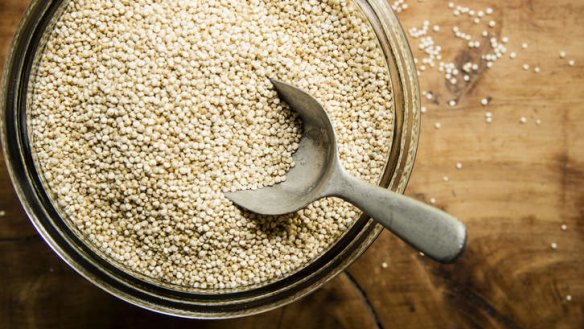Answering your culinary questions

Can I buy quinoa that won't make the Bolivians starve? J. Bennett
Thank you for the long letter outlining your concerns about how trendy vegetarians are destroying the life of native South Americans by driving up the price of quinoa. I did have to edit your question and forward it to the Letters and Opinion editors. Sad but true, the increased demand for this high-protein South American staple seed has sent prices skyrocketing and encouraged farmers to plant quinoa as a monoculture. It is a serious issue, which is why the UN declared 2013 the international year of quinoa. There is quinoa grown in the north of Tasmania. Look for retailers at biodynamic.com.au or order online at goodness.com.au.
Why is it OK to eat undercooked duck but not chicken? J. Hiscock
Raw poultry is not something you want to eat - and you don't want it hanging around your kitchen. According to a Food Standards Australia New Zealand survey of the chicken industry in 2010, ''campylobacter and, to a lesser extent, salmonella, were frequently found in samples tested'' of live chickens and chicken meat. These potentially harmful bugs can also be found on duck meat. They are rendered harmless with proper cooking of the flesh, and cleaning of kitchen utensils and surfaces. Cook your birds to a core temperature of 75C, as recommended by the Victorian Department of Health. Duck cooked to this temperature will still appear pink, or uncooked, because duck is a different beast - a domesticated migratory bird with muscle fibres that help it fly to warmer climes for the winter. The myoglobin - the stuff that helps bring oxygen to the muscle fibres - is rich in iron and remains pink even when cooked.
We caught yabbies over the Australia Day long weekend. What do we do with them? L. Sparke
Well, that's a true-blue dinkum way to spend Australia Day. You could have responded like Pavlov's dogs to the wall-to-wall advertising and thrown some lamb on the barbecue. Or you could have stuck some plastic flags that were made in China to the side of your car. But you went bush and caught some native crustaceans with a name borrowed from the first Australians. Yabbies have powerful pincers that can be avoided by counter-intuitively picking them up with thumb and index finger around the shell just behind where the pincer arms meet the body. You'll also want to purge them in cool, fresh water, covered and in a shaded spot, for 24 hours. Half an hour in the freezer will send them into a slumber that will allay your conscience as you put them into a large pot of boiling water for five or so minutes or until they change colour. Twist the tails off and peel off the shell and eat as is. For a special treat, allow the flesh to cool, lay yabby tails on thickly buttered white bread, and sprinkle with a little salt to make a delicious sandwich.
What is the best way to keep greens? R. Simonson
My fridge looks like a crazy plastic-bag collection because I loosely cover almost every vegetable in an old supermarket bag. Come dinner, I have to fondle all the packages to determine what's inside them by touch. Water loss is the biggest enemy to freshness and slowing this down through the leaves and cut surfaces helps vegetables keep longer. Anything green with the roots attached, such as herbs or hydroponically grown lettuce, will keep longer if kept in a jug or mug filled with water. Loose salad leaves, spinach or soft-leafed herbs can be rolled in a tea towel and placed in loosely wrapped plastic bag. Soft leaves, such as baby lettuce, crush easily and can be cushioned by placing in a zip-lock bag, inflating it a little by blowing into it and then sealing and refrigerating. In my experience, freshly picked vegetables grown in compost-enhanced soils last longer than conventionally grown ones.
brainfood@richardcornish.com.au
Twitter @FoodCornish
The best recipes from Australia's leading chefs straight to your inbox.
Sign up- More:
- Brain food
